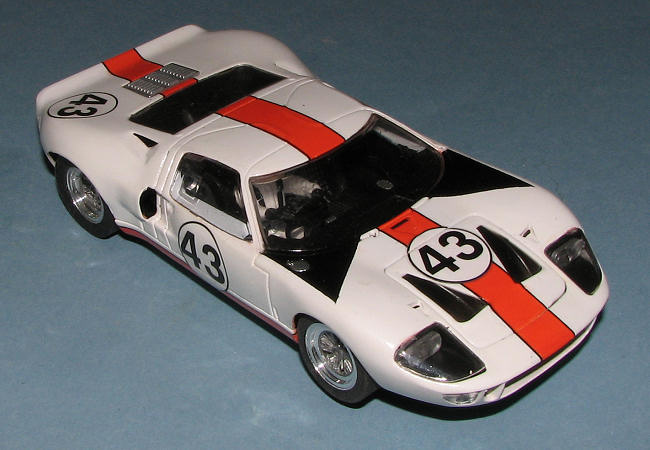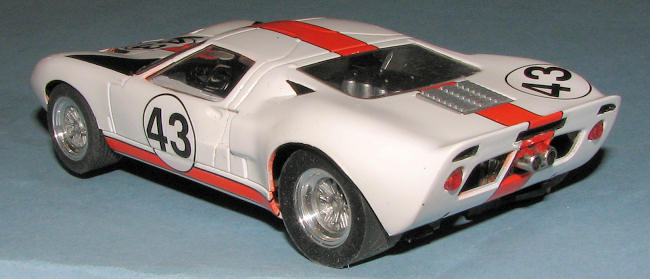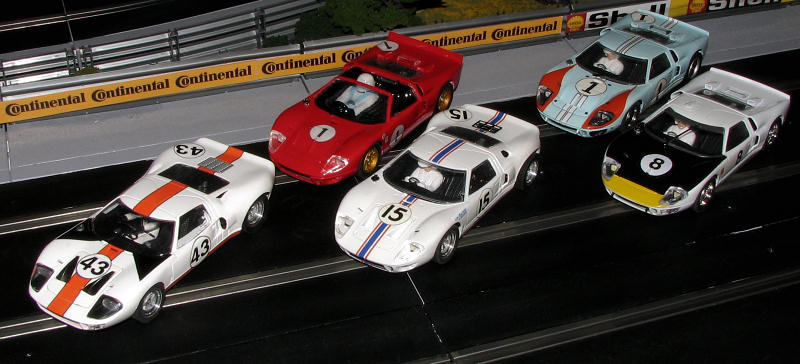BACK FROM THE GRAVE
About a year ago, I put a request on one of the slot car forums for
people to send me the remains of their dead Ford GT 40 slot cars. Quite a few
people provided me with various bits and pieces, though none sent in motors,
rear wheels/axles/bearings, light assemblies or guide shoes and the bits that go
to them. I did get quite a few upper bodies sections for both the MkI and MkII,
some clear parts, a few interiors and some other items like light covers and so
on.
I then started checking the various on-line retailers to see if I
could still buy some spares for these cars. Sure enough, lower chassis pieces
with front axles/wheels and the rear axle assembly were still available, though
for specific cars (which meant they were already painted). Motors were not a
problem as I had a number of them from various sources that would fit. Neither
were guide shoes or wire. Some of the cars had all of the drive train replaced
with bits from aftermarket (yep, there is an aftermarket for slot cars, though
mostly it is performance parts). The end result was that I've so far been
able to resuscitate four Scalextric Ford GT-40s of various types, some with stock parts and some aftermarket. None of the cars ended up
costing more than a new one, most are faster than stock, and all but one have
paint schemes not available in the market. That one was as carefully rebuilt to
near stock as I could get it.
There are still enough complete parts for two more cars and I have
at least one more body set (the Scalextric cars have separate front and rear body
sections to do the different variants) that might be usable.
For this
article, I
used a well-raced Fly car as the basis. This was the #130 Targa Florio car, but
had seen a lot of action and damage as well. Missing was the windscreen wiper
(which is still missing) and all of the
 'stuff' that goes in the back, like the exhaust. It also had a
broken windscreen post and many scrapes. However, well worth $20 (it retails for
$60) as it provided
another opportunity to bring back a car from near extinction.
'stuff' that goes in the back, like the exhaust. It also had a
broken windscreen post and many scrapes. However, well worth $20 (it retails for
$60) as it provided
another opportunity to bring back a car from near extinction.
First order of business was to remove all the parts I didn't want painted. Not
an easy task with any Fly car as the fiend with the soldering iron had truly
mushed down the various attachment pins (For those unfamiliar with slot cars,
the factories in China do not glue the parts to the body, but use a soldering
iron and melt the attachment tabs in place). Eventually all had been removed and the
car was soaked for days in 91% isopropyl. Fly bodies seem particularly immune to
this treatment to remove paint, though I was able to get rid of most the black paint and all the
decals. The rest was removed with 600 grit sandpaper.
I had chosen a fairly simple scheme for this relivery. One of my references had a
color photo of the #43 Essex Wire GT-40 driven at the 1966 Spa 1000km race. It
was white with orange racing bands trimmed in black with black
areas on the upper hood and radiator exhaust outlets. The big question mark for
me was the rear end treatment. Some GT-40 Mk I cars like this had a single tail
light and no screens as depicted on the Fly car and others had twin tail lights
on each side and screen work as in the later GT-40 Mk II. With no period photos,
I went with what the Fly car offered.
The car first had all the mold seams sanded down and then the car was painted
with Testors Boyd's Gloss White. Next the orange stripe was added (after MUCH
masking) using Tamiya
rattle can acrylic paint. Now the Fly car is only a GT 40 in name and overall
appearance is dimensionally a mess. The Scalextric GT40s are much closer
to prototype dimensions. That being said, I placed the orange stripe in the same
location as on the real car, though it is considerably narrower on the Fly
version.
 Though I thought I'd masked off everything fairly well, I did get a lot of
overspray in unwanted areas as you can see in the photos. However, it is a slot
car and zipping by, you don't see it!
Though I thought I'd masked off everything fairly well, I did get a lot of
overspray in unwanted areas as you can see in the photos. However, it is a slot
car and zipping by, you don't see it!
The black areas were then painted. After each color was applied and dried, I
sprayed on a coat of gloss clear lacquer. This allowed me to more easily remove
any glitches in the subsequent coat without damaging the underlying shade.
The thin black stripes were somewhat tedious to apply, but are required to get
the proper look. These stripes were thanks to the Yellow Wings sheet that has
them for the color boundaries on their pre-war Navy planes. I used Monogram Roundels and Number decals for this. The
roundels are a bit small, but the font of the numbers is correct. As usual, I
used multiple layers of the white roundels to cut back on bleed through. Four
layers on the nose and two on the sides. All this was given a couple of coats of
clear gloss after it all dried.
Meanwhile, I went to work on the chassis. Fly cars are notorious for out of
round wheels and this was no exception. In addition, the previous owner had
glued in the bearings, but they were not true and were binding. The car also had
a Slot.it wood guide, which was too large for my Scalextric track. The axles and
bearings and gears were replaced with slot.it components while the wheels and
the inserts are from BWA. Ninco supplied a new guide. I used Fly tires on the
front and Super Tires on the back, though these are not as tall as I'd really
like.
The car is super quiet without the usual rather loud gear whine, and while it does not look as fast as a stock Fly GT-40,
the stock one is at least 4/10s of a second slower. The modified car handles superbly and is a ton of fun to
drive. What's more, it is one more livery to add to the collection and doesn't
require that I spend a lot of money on a pricey overseas 'special edition'.
I really like these projects. I have at least two more Scalextric 'parts bin'
cars to do as well as a couple of body in white cars, so more are on the
horizon. Here is a photo of what I've managed to bring back to life so far. All
of these schemes are as historically accurate as I can make them. There are
quite a few reference photos on the Internet, though many of them are of poor
quality.

 'stuff' that goes in the back, like the exhaust. It also had a
broken windscreen post and many scrapes. However, well worth $20 (it retails for
$60) as it provided
another opportunity to bring back a car from near extinction.
'stuff' that goes in the back, like the exhaust. It also had a
broken windscreen post and many scrapes. However, well worth $20 (it retails for
$60) as it provided
another opportunity to bring back a car from near extinction. Though I thought I'd masked off everything fairly well, I did get a lot of
overspray in unwanted areas as you can see in the photos. However, it is a slot
car and zipping by, you don't see it!
Though I thought I'd masked off everything fairly well, I did get a lot of
overspray in unwanted areas as you can see in the photos. However, it is a slot
car and zipping by, you don't see it!